 |
||
|
||
| ||
Contents
3D graphics old-timers may remember the years when it took ATI half a year from the announcement to the real products (for example, RADE 128, RADEON). Of course, ATI lived a single life at that time, without partners. And it manufactured all the cards on its own. That's what we were told then, but now we know that the Canadian company had no video cards manufacturing plants, it just placed its orders to this or that plant (that is it practiced outsourcing). What has changed since those times? Of course, after the company started working with video cards manufacturers, new cards have started to appear on the shelves much earlier, however it concerns not all series. The company from Toronto still orders High-End products to some plants (in China) and actually sells off-the-shelf cards instead of chips. Partners just put their stickers and package the cards in their boxes. That was the case with the RADEON X800 (R420/423), it also carries on now with the X850 (R480). It should be noted though that with the release of the X800, the market took a step back in terms of increased period it takes new cards to hit the shelves. It concerns the X800 XT PE, which got available only in Autumn 2004, five months after its announcement. There were problems with the yield percentage of chips capable of operating at 520 MHz with 16 active pipelines. With the release of the X800 XT (not PE) the situation got a tad better, because 16-pipeline chips (which still couldn't guarantee operation at 520 MHz) could be already put to sterling use instead of being installed to the X800 PRO in their locked form. The new announcement was made on December the 1st. It's March already, three months have passed, but the X850 XT cards are already on sale. It's still much time, but the progress in comparison with the X800 XT is obvious. Manufacturing problems seem to be fixed up. What concerns the X800 XL, though it's essentially the same X800 XT operating at lower frequencies, these ATI chips are sold separately and manufacturers are free to make video cards with these chips on their own. In this article below you will find out that there are practically no difference in PCB layout between the X850 and the X800XL. But the former cards are manufactured solely on ATI's orders, while the latter cards can be manufactured by partners. The reasons are not clear. Only marketing specialists seem to see some interest here. That's how marketing specialists picture the present day competition:
So, we review three video cards from HIS (HighTech Information Systems) from Hong Kong, but only one of the cards is actually manufactured by the company – the X800 XL. As I have already mentioned, the other two (X850 series) are manufactured by ATI (let's just assume it does it on its own). However all the three cards are equipped with a proprietary cooling system, which is certainly of a special interest. But even that's not the most important thing! What's the most important is that the IceQ II Turbo series guarantees raised frequencies via a proprietary utility! Remember Gainward and its Golden Sample series. In fact HIS offers a similar functionality in video cards based on ATI chips.
Video Cards
As I have already said above, all PCBs are practically identical, being copies of the reference design. The only difference is that the X800 XL has unsoldered elements for external power supply, which is not necessary for this product. As you can see, the "non-ordered" manufacturing quality is not worse, so I still don't understand why the X850 is hidden from partners' manufacturing. Besides, they could have diversified the range of their products. Two cards from the X850 series offer VIVO, where VideoIn is based on RAGE Theater. But the X800 XL is deprived of this feature, though the PCB layout provides a seat for this element (I repeat again that they have the same PCB). Besides, all the X850 products have two DVI jacks, regular monitors with d-Sub can be connected via the corresponding adapters that come shipped with the bundle.
Let's review the cooling systems.
Bundle
Packages.
Installation and DriversTestbed configurations:
VSync is disabled. One of the most important features of the Turbo series is a bundled proprietary utility – iTurbo (by the way, its author is well known in the 3D-graphics community :). Like ExperTool from Gainward, this program (see the first screenshot) allows to raise operating frequencies of the card at one button press (see the second screenshot). Thus, the manufacturer guarantees operation of the above mentioned cards within the frequency range specified on the box stickers (see above).
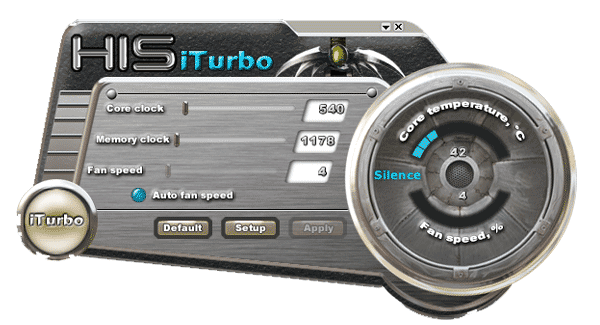
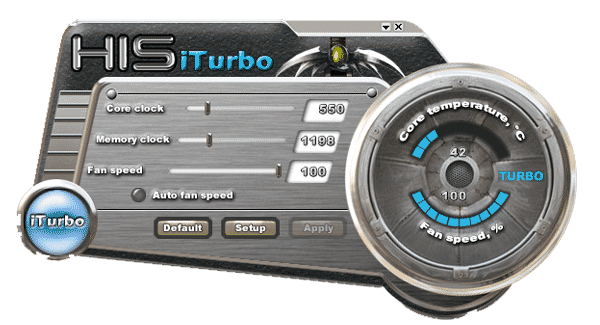 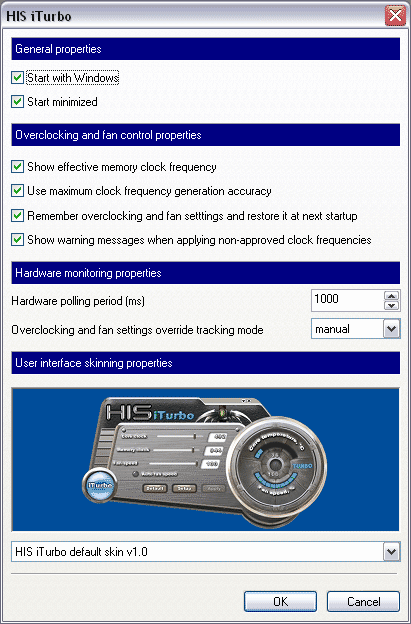 That's why remember to install iTurbo, if you buy one of such cards. In this case your video card will work a tad faster :). Test results: performance comparisonWe used the following test applications:
TR:AoD, Paris5_4 DEMO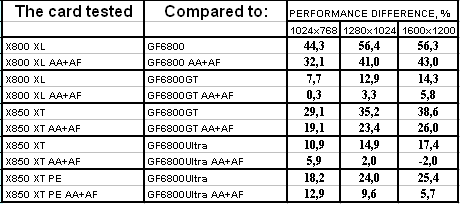 As you can see, HIS products are victorious everywhere, even in non-Turbo mode.
FarCry, Research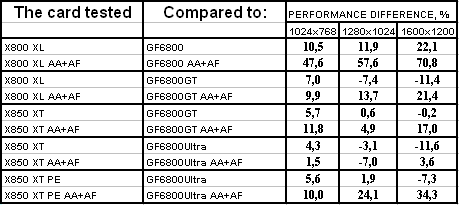 The X800 XL is obviously victorious, in fact it outscored even the 6800GT in heavy modes. But the X850XT price is somewhere between the 6800U and the 6800GT. So it's hard to judge, but we can definitely say that it's no loser. The X850 XT PE is the leader in this race.
FarCry, Regulator
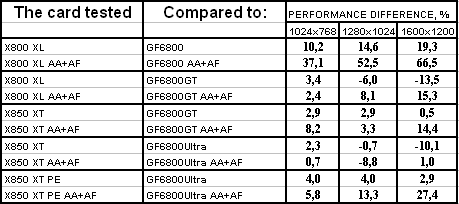 On the whole it's a similar picture.
FarCry, Pier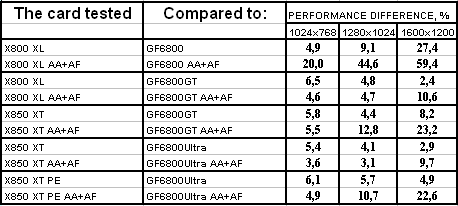 And here we can see a copy of the situation with the first test, where all HIS products are the winners.
Half-Life2: ixbt01 demo
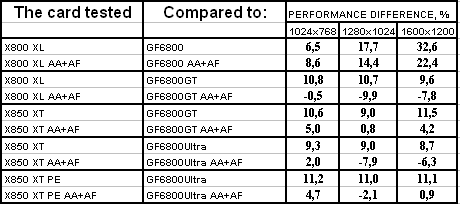 We can ignore the defeat of the X800 XL from the 6800GT in heavy modes, because they are in different price segments. In general the X800 XL is a more attractive solution here as well (with enabled iTurbo, this flaw also disappears). But the X850 XT/XT PE is approximately on a par with its competitors.
Half-Life2: ixbt02 demo
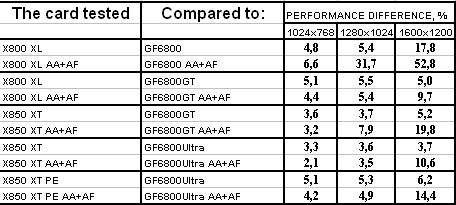 An obvious advantage of all HIS products over their competitors.
Half-Life2: ixbt03 demo
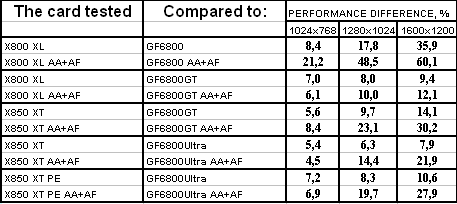 The same picture.
DOOM III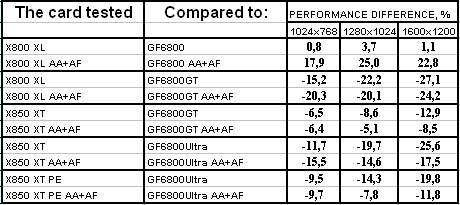 Though the X800 XL fairs very well against the 6800 PCIE, the smashing defeat from the 6800GT does not allow to give victory to the HIS product, everything will be up to the price here. Let's call it a draw. The other cards have lost the battle (this is quite expectable in this game, video cards based on ATI chips traditionally lag behind in DOOM III). 3DMark05: Game1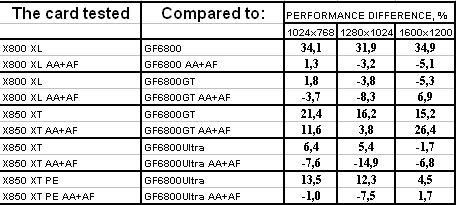
3DMark05: Game2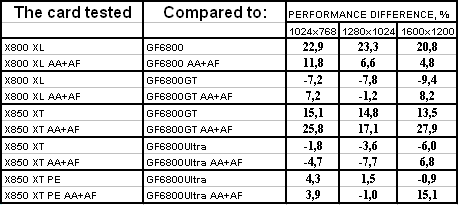
3DMark05: Game3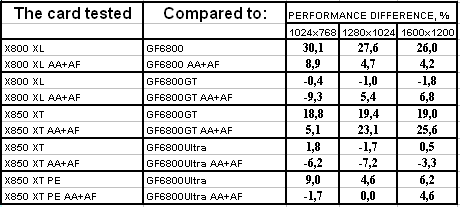
3DMark05: MARKS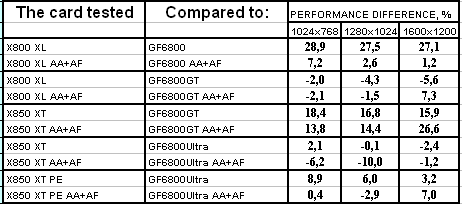 On the whole the X800 XL fairs well. Despite some defeats from the 6800GT one can say that the parity is preserved. Approximately the same situation is with the X850 cards.
Chronicles of Riddick, demo 44
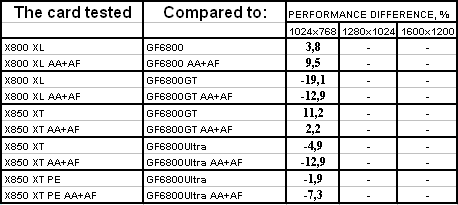 One can acknowledge a draw in the battle between the X800 XL and its competitors, but the X850 cards are obviously defeated.
Chronicles of Riddick, demo ducche
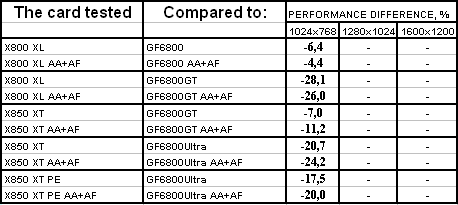 And in this case all the three products from HIS have lost the battle.
Conclusions
Just for the fun of it, I installed two video cards from HIS into the nForce4 SLI based testbed. They look great. They obviously lack an adapter to be connected to something like SLI :-). I don't hint at anything. That's out of sheer curiosity. :) In conclusion I offer you a video clip (2.6MB, AVI DivX 5.1), where one of the video cards tested today is installed into a modded computer.
In our 3Digest you can find more detailed comparisons of various video cards.
According to the test results, HIS RADEON X800 XL IceQ II Turbo 256MB 
Theoretical materials and reviews of video cards, which concern functional properties of the GPU ATI RADEON X800 (R420)/X850 (R480)/X700 (RV410) and NVIDIA GeForce 6800 (NV40/45)/6600 (NV43)
Write a comment below. No registration needed!
|
Platform · Video · Multimedia · Mobile · Other || About us & Privacy policy · Twitter · Facebook Copyright © Byrds Research & Publishing, Ltd., 1997–2011. All rights reserved. | |||||||||||||||||||||||||||||||||||||||||||||||||||